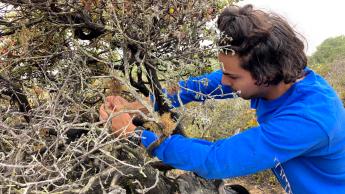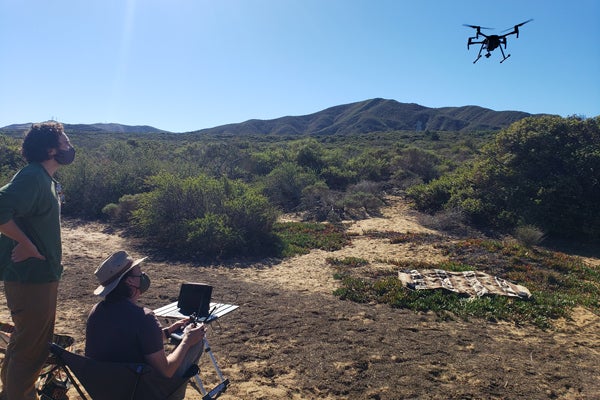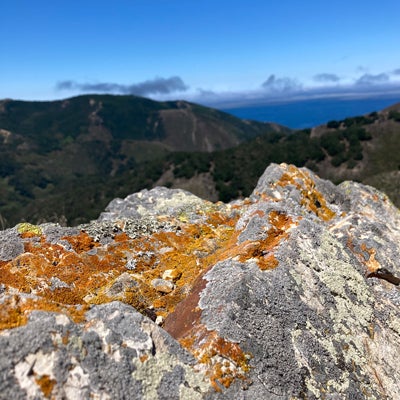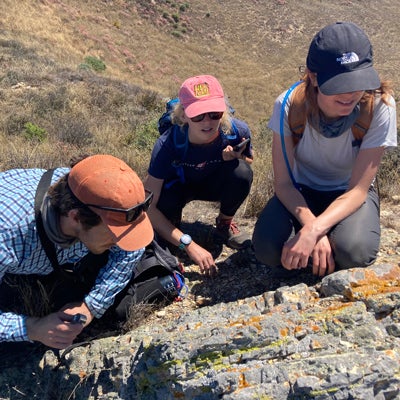Ecology’s Next Frontier: Student Researchers Hone in on Rare and Understudied Lichens

Master's student Eli Balderas conducts a transplant experiment in the field, moving rare lichens to a new habitat to see how they thrive. Photo courtesy of Professor Nishi Rajakaruna.
Lichens, the small but mighty and oft-unsung heroes of global ecosystems, present a rare opportunity for genuine scientific discovery — and this summer, Cal Poly students are part of that process.
Biology Professor Nishi Rajakaruna, who was recently part of an international team that discovered several new species of lichens in South Africa, is guiding several key research projects with the hope of educating the next generation of lichenologists.
“They are underappreciated and understudied,” Rajakaruna said. “Even though California is a heavily botanized state, very few ecologists have paid attention to this cryptic, not-so-charismatic part of the biodiversity we have here.”
These hearty organisms — a combination of fungus and algae working together — can adapt to a changing climate while pulling nitrogen from the atmosphere and helping weather rocks and other surfaces. Now scientists are finding ways to use lichen as bioindicators for things like air pollution, mineral content in rocks, or to assess an ecosystem’s health.
Eli Balderas, who is earning a master’s degree in biological sciences, is honing in on Sulcaria isidiifera, known as “the splitting yarn lichen.” The critically endangered species only grows in small pockets of maritime chaparral habitats in San Luis Obispo County.

“They grow on other federally endangered plant species,” he adds. “It's kind of like a two-for-one in very sensitive habitats.”
Balderas is conducting an ecological study, funded in part by the International Union for Conservation of Nature, with a multifaceted team: Emma Fryer, who is earning her master’s degree in biological sciences, and Alyssa Shon and Skyler McKinnon, who are part of the Frost Summer Undergraduate Research Program. Together, they’re canvassing the ecosystem, estimating the lichen’s abundance and better documenting its typical habitat. With the help of former Frost researcher Zach Raposo who now works as an environmental mapping analyst, the team is even using drones to help map species distribution.
Back on the ground, Balderas is also conducting experimental transplants of lichens, carefully moving them to new areas in a similar microclimate and assessing how well they thrive — something few ecologists have attempted before.
With this data, he plans to petition the U.S. Fish and Wildlife Department for federal listing status to protect the species. His samples will also be cataloged at Cal Poly’s Hoover Herbarium, opening the opportunity for other students to be fascinated by this small-but-mighty organism.
“I learned how much of science is learning as you go, adapting to the situation and doing what you can with the resources and time that you have. In order to make progress, you need to do things that haven't been thought over or done before,” Balderas says of his research experience. “That has led me to this realization that, no matter what I do — whether it's pursuing my PhD or going to work for a land management agency — I feel a bit more confident.”

Another research project is focused on lichens growing on rocks. Michael Mulroy, a master’s student in biological sciences at Cal Poly, is leading a lichen community ecology project, where he samples species growing on serpentine and sandstone outcrops across several counties on the Central Coast, from the foggy coastline to warmer inland environments.
“The idea is to quantitatively assess what species are occurring where, what the composition is of these lichen communities in these different rock outcrops, and take measurements on the elemental composition of the rocks, their slope and aspect to determine the relative importance of these abiotic factors in lichen distribution,” says Mulroy. Thanks to grants from the California Lichen Society, the American Bryological and Lichenological Society and others, he’s investigating whether climate influence near the ocean makes a bigger difference in what species appear there compared to inland habitats.
The focus on serpentinite, a rock full of heavy metals like nickel, is no coincidence. It is California’s state rock and played a critical role in the state’s early mining industries. Studies show serpentine-derived soils support about 270 of California’s endemic plant species — up to 15% of plant life unique to the Golden State.
“No one has really looked at the relative importance of these climatic variables, with the geologic variables anywhere at this scale that Michael is studying it, which also makes this study pretty novel from a global perspective,” echoes Rajakaruna. Mulroy and Rajakaruna, along with three U.S.-based lichenologists serving on Mulroy’s graduate committee, often confer with an international community of lichenologists and ecologists — including experts from Russia and Italy — comparing their data and research practices in this emerging field.

At the same time, Mulroy and his coauthors are working to publish findings from a sweeping survey of lichens from across North America. He teamed up with Amanda Gersoff, a researcher in the Frost Summer Undergraduate Research Program who earned her bachelor’s degree in environmental management and protection, to create a database of lichen ecology and distribution records for more than 350 species growing on ultramafic rocks, including serpentinite, across the continent.
The study could be key in better describing the biodiversity of lichens and identifying dozens of new species living on serpentine while opening up new angles for future research. The pair plan to present their findings at the International Conference on Serpentine Ecology in Yekaterinburg, Russia next year.
Gersoff says her work on the project sharpened her data analysis, technical writing and field work technique while deepening her fascination with lichens.
“I have no doubt that the skills I gained during this project will be helpful for completing my own master’s thesis,” she says.
Rajakaruna takes pride knowing the students he mentors will be among a handful of people in the world with this keen expertise.
“I feel like training students to get into areas that are understudied will benefit them more in terms of their career potential than getting them to do projects in fields that many others are working on,” says Rajakaruna.
Every summer, more than 400 students in the College of Science and Mathematics work side-by-side with professors in their research labs. The Frost Summer Undergraduate Research Program provides stipends that allow students to do research full time. Throughout the year, more than 1,000 undergraduate researchers in the college receive around $1.2 million to engage in research with faculty mentors. Visit the college website for more information.
Don't want to miss any cool Cal Poly News stories? Sign up for our monthly newsletter, the Cal Poly News Recap!




